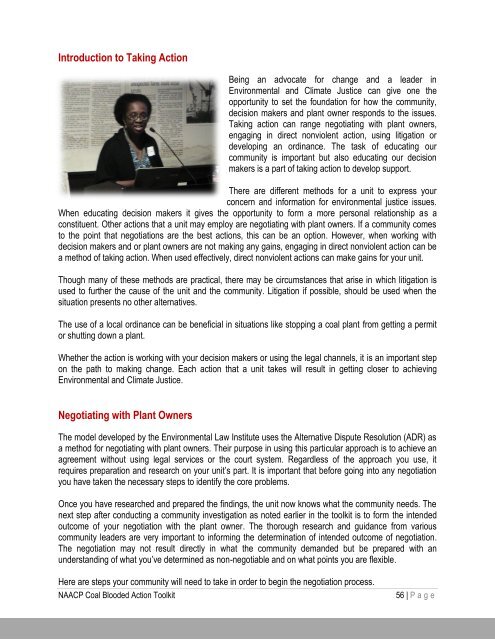Coal Blooded Action Toolkit - Climate Access
Coal Blooded Action Toolkit - Climate Access
Coal Blooded Action Toolkit - Climate Access
- No tags were found...
You also want an ePaper? Increase the reach of your titles
YUMPU automatically turns print PDFs into web optimized ePapers that Google loves.
Introduction to Taking <strong>Action</strong>Being an advocate for change and a leader inEnvironmental and <strong>Climate</strong> Justice can give one theopportunity to set the foundation for how the community,decision makers and plant owner responds to the issues.Taking action can range negotiating with plant owners,engaging in direct nonviolent action, using litigation ordeveloping an ordinance. The task of educating ourcommunity is important but also educating our decisionmakers is a part of taking action to develop support.There are different methods for a unit to express yourconcern and information for environmental justice issues.When educating decision makers it gives the opportunity to form a more personal relationship as aconstituent. Other actions that a unit may employ are negotiating with plant owners. If a community comesto the point that negotiations are the best actions, this can be an option. However, when working withdecision makers and or plant owners are not making any gains, engaging in direct nonviolent action can bea method of taking action. When used effectively, direct nonviolent actions can make gains for your unit.Though many of these methods are practical, there may be circumstances that arise in which litigation isused to further the cause of the unit and the community. Litigation if possible, should be used when thesituation presents no other alternatives.The use of a local ordinance can be beneficial in situations like stopping a coal plant from getting a permitor shutting down a plant.Whether the action is working with your decision makers or using the legal channels, it is an important stepon the path to making change. Each action that a unit takes will result in getting closer to achievingEnvironmental and <strong>Climate</strong> Justice.Negotiating with Plant OwnersThe model developed by the Environmental Law Institute uses the Alternative Dispute Resolution (ADR) asa method for negotiating with plant owners. Their purpose in using this particular approach is to achieve anagreement without using legal services or the court system. Regardless of the approach you use, itrequires preparation and research on your unit’s part. It is important that before going into any negotiationyou have taken the necessary steps to identify the core problems.Once you have researched and prepared the findings, the unit now knows what the community needs. Thenext step after conducting a community investigation as noted earlier in the toolkit is to form the intendedoutcome of your negotiation with the plant owner. The thorough research and guidance from variouscommunity leaders are very important to informing the determination of intended outcome of negotiation.The negotiation may not result directly in what the community demanded but be prepared with anunderstanding of what you’ve determined as non-negotiable and on what points you are flexible.Here are steps your community will need to take in order to begin the negotiation process.NAACP <strong>Coal</strong> <strong>Blooded</strong> <strong>Action</strong> <strong>Toolkit</strong>56 | P a g e











